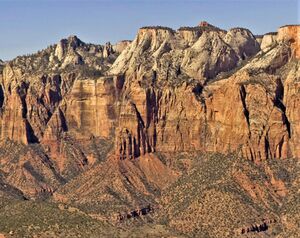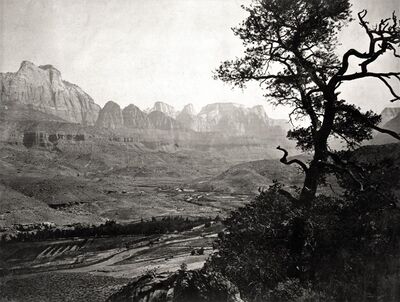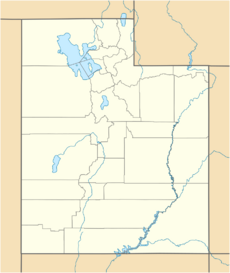Earth:Meridian Tower (Zion National Park)
| Meridian Tower | |
|---|---|
 Meridian Tower (flat top, centered) seen from the SSE from the summit of The Watchman | |
| Highest point | |
| Elevation | 7,340 ft (2,240 m) [1] |
| Prominence | 180 ft (55 m) [1] |
| Parent peak | Point 7455 (7,455 ft)[1] |
| Isolation | 0.34 mi (0.55 km) [1] |
| Coordinates | [ ⚑ ] : 37°13′52″N 113°00′05″W / 37.2310876°N 113.0012777°W [2] |
| Geography | |
| Location | Zion National Park Washington County, Utah United States |
| Parent range | Colorado Plateau |
| Topo map | USGS Springdale West |
| Geology | |
| Age of rock | Jurassic |
| Type of rock | Navajo sandstone |
| Climbing | |
| First ascent | 2016, Stih and Mower |
| Easiest route | class 5.8 climbing |
Meridian Tower is a 7,340-foot (2,240 m) Navajo Sandstone mountain in Zion National Park in Washington County, Utah, United States,[2] that is part of the Towers of the Virgin
Description
Meridian Tower is situated 2 mi (3.2 km) northwest of Zion's park headquarters, towering 3,350 feet (1,020 m) above the floor of Zion Canyon and the Virgin River which drains precipitation runoff from this mountain. Its neighbors include The West Temple, The Sundial, The Witch Head, Altar of Sacrifice, Bee Hive, and The Sentinel. This feature was so named by the park's third superintendent, Preston P. Patraw, because its flat top is crossed by the 113th meridian.[2] Meridian Tower's name was officially adopted in 1934 by the U.S. Board on Geographic Names. The first ascent of Meridian Tower was not made until March 2016 by Dan Stih and Matt Mower.[3]
Climate
Spring and fall are the most favorable seasons to view Meridian Tower. According to the Köppen climate classification system, it is located in a Cold semi-arid climate zone, which is defined by the coldest month having an average mean temperature below 32 °F (0 °C), and at least 50% of the total annual precipitation being received during the spring and summer. This desert climate receives less than 10 inches (250 millimeters) of annual rainfall, and snowfall is generally light during the winter.[4]

See also
- List of mountains of Utah
- Geology of the Zion and Kolob canyons area
- Colorado Plateau
References
- ↑ Jump up to: 1.0 1.1 1.2 1.3 "Meridian Tower - 7,340' UT". https://listsofjohn.com/peak/20734. Retrieved 2020-09-13.
- ↑ Jump up to: 2.0 2.1 2.2 U.S. Geological Survey Geographic Names Information System: Meridian Tower
- ↑ American Alpine Journal, 2017, publications.americanalpineclub.org
- ↑ "Zion National Park, Utah, USA - Monthly weather forecast and Climate data". Weather Atlas. https://www.weather-us.com/en/utah-usa/zion-national-park-climate.
External links
- Zion National Park National Park Service
- Meridian Tower: Weather forecast
 |



